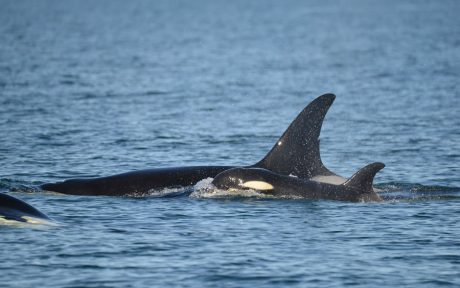News from Center for Whale Research
Posted October 29, 2016 at 5:46 am by Tim Dustrude

J28 with “peanut-head” and J54 malnourished on 2 October 2016 – Photo by Ken Balcomb, Center for Whale Research
By Kenneth C. Balcomb,
Senior Scientist Center for Whale Research
J28 was born in mid-winter 1992/93 in or near Puget Sound Washington, and was the first of four known calves born to J17 in the J9/J5 lineage of southern resident killer whales (SRKW – see family tree) inhabiting the inshore marine waters of the Pacific Northwest. The iconic and world-famous J1, first SRKW ever to be photo-identified, was her father. Photographs of J28 that were taken in the summer of 1993 by Center for Whale Research staff and Earthwatch volunteers show that she was a healthy and vigorous ‘calf’’ among six new calves born that year into the SRKW population.
In late autumn 2002, when J28 was nine years old she acquired a small nick in the trailing edge of her dorsal fin that made her easily identifiable to whale-watchers and the general public, and she became one of the darlings for a growing fan club of humans that were beginning to raise concerns that this iconic population was precipitously declining from around 100 in 1995 to around 80 in 2003. The SRKW population was declared Endangered under the US Endangered Species Act in 2005, and earlier this year it was listed as a “species in the spotlight” by NOAA for its lack of recovery since then.
Sexual maturity for these immensely popular neighbor animals is typically attained in the early to mid teens, and J28 had her first known calf, a daughter J46, in November 2009 when she was sixteen years old. Gestation is approximately 17 months, so we can estimate that J28 became pregnant at age fourteen and a half. In January 2013 (three years after the birth of J46), a freshly dead neonate calf was found on Dungeness Spit and identified from DNA as belonging to J28 with the father most likely to have been L41. The dead calf was not given an alpha-numeric designation because it had not been documented alive. She subsequently (23 months after the dead calf) had her second live-born calf, a son J54, in December 2015 at the tail end of a so-called “Baby Boom” of 2014/15. Regrettably now that mom has died, he will not survive and may already be dead, along with two other “boomers” (J55 and L120). (Continue reading here)
You can support the San Juan Update by doing business with our loyal advertisers, and by making a one-time contribution or a recurring donation.










No comments yet. Be the first!
By submitting a comment you grant the San Juan Update a perpetual license to reproduce your words and name/web site in attribution. Inappropriate, irrelevant and contentious comments may not be published at an admin's discretion. Your email is used for verification purposes only, it will never be shared.